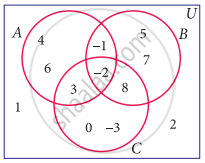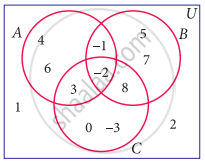Advertisements
Advertisements
प्रश्न
Using the adjacent Venn diagram, find the following set:
A – (B ∪ C)
उत्तर
From the diagram we get
U = {−3, −2, −1, 0, 1, 2, 3, 4, 5, 6, 7, 8},
A = {−2, −1, 3, 4, 6}
B = {−2,−1, 5, 7, 8}
C = {−3, −2, 0, 3, 8}
A’ = U – A
= {−3, −2, −1, 0, 1, 2, 3, 4, 5, 6, 7, 8} – {– 2, –1, 3, 4, 6}
= {– 3, 0, 1, 2, 5, 7, 8}
B’ = U – B
= {– 3, – 2, – 1, 0, 1, 2, 3, 4, 5, 6, 7, 8} – {– 2, –1, 5, 7, 8}
= {– 3, 0, 1, 2, 3, 4, 6}
B ∪ C = {– 2, –1, 5, 7, 8} ∪ {– 3, – 2, 0, 3, 8}
= {– 3, – 2, –1, 0, 3, 5, 7, 8}
B ∩ C = {– 2, –1, 5, 7, 8} ∩ {– 3, – 2, 0, 3, 8}
= {– 2, 8}
A – (B ∪ C) = {– 2, – 1, 3, 4, 6} – {– 3, – 2, –1, 0, 3, 5, 7, 8}
= {4, 6}
APPEARS IN
संबंधित प्रश्न
Using the adjacent Venn diagram, find the following set:
A’ ∩ B’
Using the adjacent Venn diagram, find the following set:
A – (B ∩ C)
If K = {a, b, d, e, f}, L = {b, c, d, g} and M = {a, b, c, d, h} then find the following:
K ∩ (L ∪ M)
If K = {a, b, d, e, f}, L = {b, c, d, g} and M = {a, b, c, d, h} then find the following:
(K ∩ L) ∪ (K ∩ M) and verify distributive laws
If A = {x : x ∈ Z, −2 < x ≤ 4}, B = {x : x ∈ W, x ≤ 5}, C = {− 4, −1, 0, 2, 3, 4} verify A ∪ (B ∩ C) = (A ∪ B) ∩ (A ∪ C)
If A = {x : x = 6n, n ∈ W and n < 6}, B = {x : x = 2n, n ∈ N and 2 < n ≤ 9} and C = {x : x = 3n, n ∈ N and 4 ≤ n < 10}, then show that A – (B ∩ C) = (A – B) ∪ (A – C)
If A = {– 2, 0, 1, 3, 5}, B = {–1, 0, 2, 5, 6} and C = {–1, 2, 5, 6, 7}, then show that A – (B ∪ C) = (A – B) ∩ (A – C)
If A = `{y : y = ("a"+1)/2, "a" ∈ "W" and "a" ≤ 5}`, B = `{y : y = (2"n" – 1)/2, "n" ∈ "W" and "n" < 5}` and C = `{-1, −1/2, 1, 3/2, 2}` then show that A – (B ∪ C) = (A – B) ∩ (A – C)
Verify A – (B ∩ C) = (A – B) ∪ (A – C) using Venn diagrams
If U = {4, 7, 8, 10, 11, 12, 15, 16}, A = {7, 8, 11, 12} and B = {4, 8, 12, 15}, then verify De Morgan’s Laws for complementation
